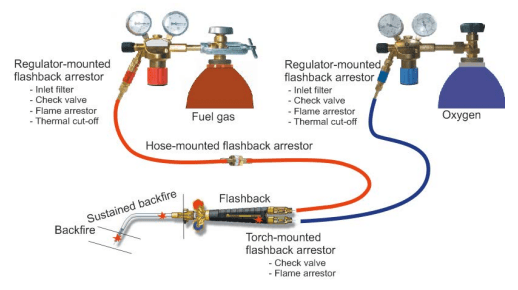Prometheus21
Mechanical
Hi everyone,
This is a bit outside my usual purview, so I'm turning to you.
My company sells pressure regulators for (mostly) industrial gases, like oxygen, nitrogen and hydrogen, as well as flexible hoses that gets attached to the pressure regulator. The assembly is performed by the customer.
Now the pressure regulator gets attached to the 200 bar H2 cylinder. The flexible hose (typically 1/4'' inner diameter tubing) then gets attached to regulator. For applications involving welding, cutting ect. you would install a flashback arrestors (also known as flash arrestor) between the hose and the regulator; the idea being it would stop the reverse flow of gas as well as flash back into the regulator and the cylinder itself.
Now the pressure regulator is rated for a cylinder pressure of 200 bar (P1), where the working pressure (P2) can either be 1-10 bar, or 10-200 bar. The highest rated flashback arrestor for this application (to my knowledge - and after asking multiple distributors in my region (Europe)) is for a working pressure of 17 bar, and the cost is sky-high.
I now have a customer (plant manager) that wants a flashback arrestor rated for 200 bar H2 fitted between the flexible hose and the pressure regulator.
Now the pressure regulator is of course equipped with a pressure relief device in case of failure. But I have never before seen or heard anything about installing a 200 bar flashback arrestor between a flexible hose and the pressure regulator mounted on the H2 cylinder. It just hasnt been done before to my knowledge. In the words of one of the distributors I reached out to: a flashback arrestor with that spec has never been, and will never be, manufactured.
Now my question is this: Has any of you ever heard of such a thing? Are there any rules and regulations in place (Europe) I'm not aware of? In my experience so far every customer that uses H2 for cutting and welding uses a 200 bar cylinder, with a mounted pressure regulator with a working pressure between 1-10 bar, with a flashback arrestor if needed. For higher working pressures than 17 bar, no such equipment exists...
Thoughts?
This is a bit outside my usual purview, so I'm turning to you.
My company sells pressure regulators for (mostly) industrial gases, like oxygen, nitrogen and hydrogen, as well as flexible hoses that gets attached to the pressure regulator. The assembly is performed by the customer.
Now the pressure regulator gets attached to the 200 bar H2 cylinder. The flexible hose (typically 1/4'' inner diameter tubing) then gets attached to regulator. For applications involving welding, cutting ect. you would install a flashback arrestors (also known as flash arrestor) between the hose and the regulator; the idea being it would stop the reverse flow of gas as well as flash back into the regulator and the cylinder itself.
Now the pressure regulator is rated for a cylinder pressure of 200 bar (P1), where the working pressure (P2) can either be 1-10 bar, or 10-200 bar. The highest rated flashback arrestor for this application (to my knowledge - and after asking multiple distributors in my region (Europe)) is for a working pressure of 17 bar, and the cost is sky-high.
I now have a customer (plant manager) that wants a flashback arrestor rated for 200 bar H2 fitted between the flexible hose and the pressure regulator.
Now the pressure regulator is of course equipped with a pressure relief device in case of failure. But I have never before seen or heard anything about installing a 200 bar flashback arrestor between a flexible hose and the pressure regulator mounted on the H2 cylinder. It just hasnt been done before to my knowledge. In the words of one of the distributors I reached out to: a flashback arrestor with that spec has never been, and will never be, manufactured.
Now my question is this: Has any of you ever heard of such a thing? Are there any rules and regulations in place (Europe) I'm not aware of? In my experience so far every customer that uses H2 for cutting and welding uses a 200 bar cylinder, with a mounted pressure regulator with a working pressure between 1-10 bar, with a flashback arrestor if needed. For higher working pressures than 17 bar, no such equipment exists...
Thoughts?

